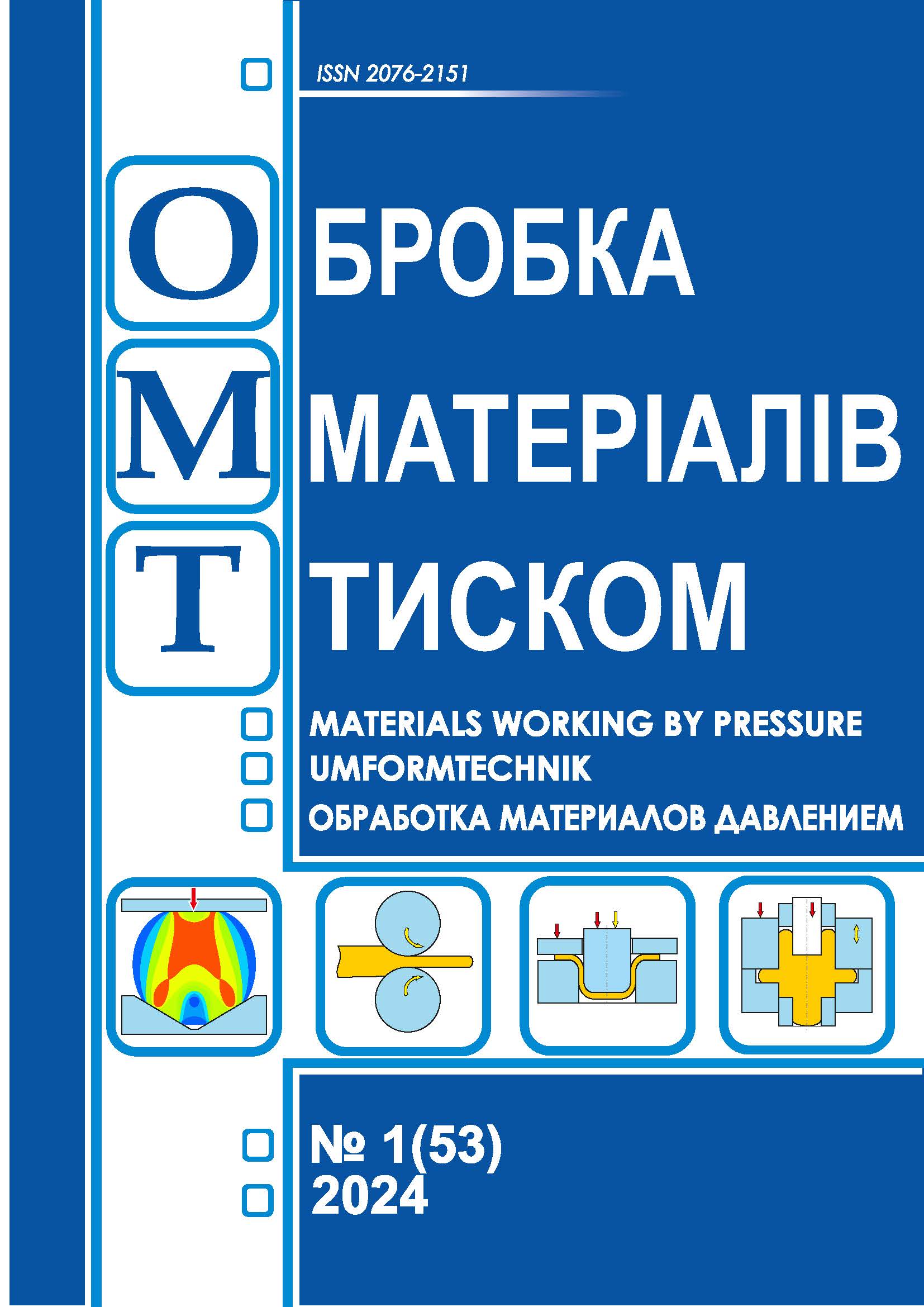Simulation of the force regime for lateral extrusion in a die with rounded areas
DOI:
https://doi.org/10.37142/2076-2151/2024-1(53)10Keywords:
lateral extrusion, rounded edge of the die, method of kinematic modules, triangular curvilinear module, reduced deformation pressure, die opening pressure.Abstract
Levchenko V., Aliieva L., Abhari P., Titov A., Chepelenko O.
Simulation of the force regime for lateral extrusion in a die with rounded areas.
A triangular curvilinear kinematic module for simulating the force mode of the lateral extrusion process by the upper bound method was developed, which allowed to estimate the influence of the geometric parameters of the profiled dies on the deformation pressure. In the paper, the properties and possibilities of the triangular curvilinear module for the analysis of the process of transverse lateral extrusion of the ledge in a die with a rounded transition area were considered. It was found that the curvilinear module does not have the property of inversion. To determine the reduced die opening pressure at the transition edge of the die for the curvilinear module, the approach of implementation of the half-die virtual movement and obtaining the function, applying equation of the power balance on the kinematically possible movement speeds was used. The technique of developing a velocity hodograph and obtaining calculation formulas for both deformation pressures and opening pressures of dies with rounded sections is described. Graphical analysis of the dependences of reduced deformation pressures and die opening pressures showed that the parameter – the relative thickness of the process h/Rm, which characterizes the degree of metal compression on the transitional rounded edge of the die, has the greatest influence on the pressure level. The optimization parameter was the angle β, which corresponded to the position of the velocity break line at the exit from the deformation zone. For engineering calculations of power modes, simplified formulas, that adequately describe the influence of technological parameters, were proposed. Recommendations for calculating force parameters of extrusion with using the proposed triangular curvilinear module can be applied for the design of extrusion processes of both parts with ledges and hollow products with tools having rounded shape-forming surfaces.
References
Forging and stamping. Handbook in 4 v. V. 3. Cold die forging. Ed. E.I. Semenov et al. Moscow: Me-chanical Engineering. 1987. 384 p. (in Russian).
Aliieva L. I. Improvement of combined extrusion processes: monograph. Kramatorsk: LLC "Tiraj-51". 2018. 352 p. ISBN 978-966-379-846-2. (in Russian).
Forging Solutions. Design Engineering Information FIA. Cold Forging. 28 p.
https://www.forging.org/uploaded/content/members/field_document/ColdForgingArticles.pdf
Aliev I. S. Radial extrusion processes. Soviet Forging and Metal Stamping Technology. English Transla-tion of Kuznechno-ShtampovochnoeProizvodstvo. 1988. Part 3, pp. 54–61. ISSN 0891-334x.
Balendra R. Injection forging: Engineering and research. Journal of Materials Processing. 2004. 145, pp. 189–206.
Aliiev I., Aliieva L., Grudkina N., Zhbankov I. Prediction of the variation of the form in the processes of extrusion. Metallurgical and Mining Industry. 2011. 3–7, pp. 17–22.
Lee H. Y., Hwang B. B., Lee S. H. Forming load and deformation energy in combined radial backward extrusion process. Proceedings of the Int. Conf. “Metal Forming 2012” 16-19.09.2012, AGH, Krakow. pp. 487–490.
Wälder J., Liewald M. Hollow lateral extrusion of tubular billets – further development of the cold forg-ing process. Applied Mechanics and Materials. 2015. 794, pp. 160–165. https://doi.org/10.4028/www.scientific.net/AMM.794.160
Kalyuzhnyi V. L., Aliieva L. I., Kartamyshev D. A., Savchinskii I.G. Simulation of cold extrusion of hollow parts. Metallurgist. 2017. 61. 5–6, pp. 359–365. https://doi.org/10.1007/s11015-017-0501-1
Farhoumand A., Ebrahimi R. Analysis of forward–backward–radial extrusion process. Materials and Design. 2009. 30, pp. 2152–2157.
Unksov E. P., Johnson U., Kolmogorov V. L., Ogorodnikov V. A., et al. Theory of forging and stamping. Ed. E.P. Unksov, A.G. Ovchinnikov. Moscow: Mechanical Engineering. 1992. 720 p. (in Russian)
Lee Y. S., Hwang S. K., Chang Y. S., Hwang B. B. The forming characteristics of radial-forward extru-sion. Journal of Materials Processing Technology. 2001. 113, pp. 136–140. https://doi.org/10.1016/S0924-0136(01)00705-1
Jafarzadeh H., Zadshakoyan M., Abdi Sobbouhi E. Numerical studies of some important design factors in radial–forward extrusion process. Materials and Manufacturing Processes. 2010. 25, pp. 857–863.
Choi H. J. Hwang B. B. The forming characteristics of radial–backward extrusion. Journal of Materials Processing Technology. 2001. 113, pp. 141–147. https://doi.org/10.1016/S0924-0136(01)00703-8
Pepelnjak T., Milutinović M., Plančak M. The Influence of extrusion ratio on contact stresses and die elastic deformations in the case of cold backward extrusion. Strojniškivestnik. Journal of Mechanical Engineering. 2016. 62. 1, pp. 41–50. https://doi.org/10.5545/sv-jme.2015.3051
Aliev I. S., Lobanov A. I., Borisov R. S., Savchinskij I. G. Investigation of die blocks with split matrixes for the processes of cross extrusion. Forging and Stamping Production (Materials Working by Pressure). 2004. 8,
pp. 21–26.
Abhari P. B., Aliieva L. I., Aliiev I. S., Eremina A. A. Development of dies for extrusion in split dies. Materials Working by Pressure. Kramatorsk: DSEA. 2016. 1(42), pp. 223–231. (in Russian).
Alyushin Yu.A., Elenev S.A. Theoretical foundations of energy methods for calculation of metal form-ing processes: Textbook. RISHM. Rostov on Don. 1987. 106 p. (in Russian).
Aliiev I. S. A technique for analyzing the processes of precise forging using modular velocity fields. Development and research of highly efficient technological processes, tooling and equipment. Metals Forming by Pressure: Thematic collection of scientific works. Kyiv: UMK VO. 1990, pp. 7–17. (in Russian).
Hrudkina N., Aliiev I., Markov O., .Sukhovirska L., Tahan L. Designing a kinematic module with round-ing to model the processes of combined radial-longitudinal extrusion involving a tool whose configuration is com-plex. Eastern-European Journal of Enterprise Technologies. 2021. 2 (1–110), pp. 81–89. https://doi.org/10.15587/1729-4061.2021.227120
Aliieva L. I., Titov A. V., Kordenko M. Yu. Simulation of the processes of transverse lateral extrusion. Materials Working by Pressure. Kramatorsk: DSEA. 2019. 1 (48), pp. 35–44. (in Russian).
Aliieva L. I. Zhbankov Ya. G. Selection of kinematic modules for determining the force parameters of radial extrusion. Bulletin of DSEA. Kramatorsk 2006. 3 (5), pp. 108–113. (in Russian).
Stepanskiy L. G. Calculations of metal forming processes. Moscow: Mechanical Engineering. 1982. 217 p. (in Russian).

